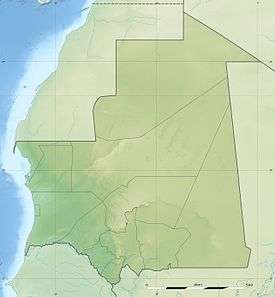Dhar Tichitt
| Dhar Tichitt | |
|---|---|
 Dhar Tichitt | |
| Location | Mauritania |
| Coordinates | 18°27′06″N 9°24′19″W / 18.4517°N 9.40528°WCoordinates: 18°27′06″N 9°24′19″W / 18.4517°N 9.40528°W |
Dhar Tichitt is a Neolithic archaeological site located in the southwestern region of the Sahara Desert, in Mauritania. It is one of several settlement locations along the sandstone cliffs in the area. The cliffs were inhabited by pastoralists starting at around 4000 BP and lasted to around 2000 BP. This area is one of the oldest known archaeological occupation sites in the western part of Africa.
Geography
The climate around the Dhar Tichitt region is very arid and hot. However, this was not always the case. Research has shown that the area used to be much more temperate during a time referred to as the Nouakchottian. During this humid phase the area was much more habitable. The Dhar Tichitt region was like this from around 5000 to 3000 before present (BP). During this time the climate was a mixture of two different seasons, a dry season and a shorter rainy season. At around 2500 BP there was a change in the climate and it became too dry for people to stay in the area.[1]
Archaeology
This site is considered a Neolithic site. The Neolithic period in Africa is marked by a change from hunter-gatherer lifestyles towards agricultural or pastoralist ones. The Dhar Tichitt region was inhabited by pastoralists around 2000 BC. Though occupied yearly, some areas were used during the dry season site whereas others were used in the rainy season. These sites have been excavated and analyzed by archaeologist Augustin Holl. They are known as Site 38 and Site 46. The latter location is found down in a sandy depression, and Site 38 sits up on the plateau.
The faunal evidence at the Dhar Tichitt area is highly diverse and this is not surprising given the history of the area. Cattle, sheep, and goats are the most common faunal remains at Site 36 with these also accounting for the majority of the faunal remains found at the site in general. Other faunal remains at these sites include crocodile, hippopotamus, ostrich, gazelle, fish, and very few representative bones of other animals. Given the amount of faunal remains that are from domesticated animals it is safe to say that this was a pastoralist society.
The botanical remains at the site reveal that not only were the people here pastoralists but that they also had some cultivation skills. Pennisetum or bulrush millet is the only domesticate found at this site. There were other botanical remains at these sites but all were most likely used as emergency foods for the people during the dry season.
There are two settlement locations at these sites. The first is heavy dry-stone structures and the other is a scattering of archaeological material with no real structures in the area. This evidence supports the hypothesis that there was occupation at two different places during a full year. The heavy masonry would serve well during the rainy season being up on the plateau and the less structural during the dry season down near where the water would be.
References
- ↑ Holl, Augustin F.C. "Coping with uncertainty: Neolithic life in the Dhar Tichitt-Walata, Mauritania, (ca. 4000–2300 BP)". Comptes Rendus Geoscience. 341 (8-9): 703–712. doi:10.1016/j.crte.2009.04.005.
Further reading
- Holl, Augustin (1985), "Subsistence patterns of the Neolithic, Mauritania", African Archaeological Review, 3: 151–162, doi:10.1007/bf01117458, JSTOR 25130453.